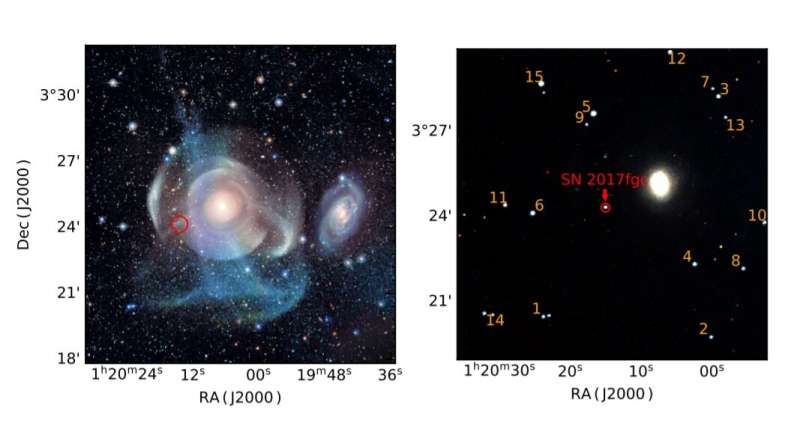
Using ground-based facilities, astronomers from China and elsewhere have conducted extensive optical photometric and spectroscopic observations of the supernova SN 2017fgc, which exploded in the galaxy NGC 474. Results of the study, published June 23 on arXiv.org, indicate that this explosion is a fast-expanding Type Ia supernova.
Type Ia supernovae (SN Ia) are found in binary systems in which one of the stars is a white dwarf. Stellar explosions of this type are important for the scientific community, as they offer essential clues into the evolution of stars and galaxies.
SN 2017fgc was detected on July 9, 2017 by the Distance Less Than 40 Mpc (DLT40) survey. Further studies of SN 2017fgc classified it as a normal supernova of Type Ia and found that it exploded in the nearby shell galaxy NGC 474 at a distance of some 96.2 million light years.
Now, new observations of SN 2017fgc conducted by a team of astronomers led by Xiangyun Zeng of the Xinjiang Astronomical Observatory in China, shed more light on the properties of this SN. The team used a set of various observatories for their study, including the 0.8 m Tsinghua NAOC telescope (TNT).
The researchers monitored SN 2017fgc from 12 days before to around 389 days after its maximum brightness. The observations found that the SN has an absolute peak magnitude of about −19.32 mag and a post-peak decline at a level of 1.05 mag. Its peak luminosity was measured to be approximately 13.2 tredecillion erg/s, what indicates a synthesized nickel mass of about 0.51 solar masses.
The spectral evolution of SN 2017fgc suggests that it is a high-velocity (HV) SN Ia. It was noted that it has a maximum-light Si II velocity of about 15,000 km/s and a post-peak velocity gradient at a level of some 120 km/s/d. Moreover, the light curve and color curve evolution of SN 2017fgc turned out to be similar to those of other fast-expanding HV SNe Ia such as SN 2002bo and SN 2006X.
However, the study found that SN 2017fgc is located far away (about 61,600 light years) from the center of its host galaxy, while HV SNe Ia usually explode near the center of their hosts.
"It seems that SN 2017fgc is an outlier and does not follow this trend of HV SNe Ia. However, closer inspection of the host galaxy NGC 474 reveals that it is a massive lenticular galaxy that experienced a merger ∼ 2 Gyr ago. (...) We speculate that SN 2017fgc could be ejected from the inner part of the companion galaxy NGC 470 during the merger that took place at ∼2 Gyr ago, or formed as a result of some cold gas remaining in the companion disk," the astronomers write.
They added that more observations, focused on the host environment of SN 2017fgc, are needed to confirm this assumption.
Explore further
© 2021 Science X Network
Citation: A fast-expanding Type Ia supernova exploded in NGC 474, study finds (2021, June 30) retrieved 30 June 2021 from https://ift.tt/3y3uNQM
This document is subject to copyright. Apart from any fair dealing for the purpose of private study or research, no part may be reproduced without the written permission. The content is provided for information purposes only.
"type" - Google News
June 30, 2021 at 07:40PM
https://ift.tt/3y3uNQM
A fast-expanding Type Ia supernova exploded in NGC 474, study finds - Phys.org
"type" - Google News
https://ift.tt/2WhN8Zg
https://ift.tt/2YrjQdq
Bagikan Berita Ini














0 Response to "A fast-expanding Type Ia supernova exploded in NGC 474, study finds - Phys.org"
Post a Comment